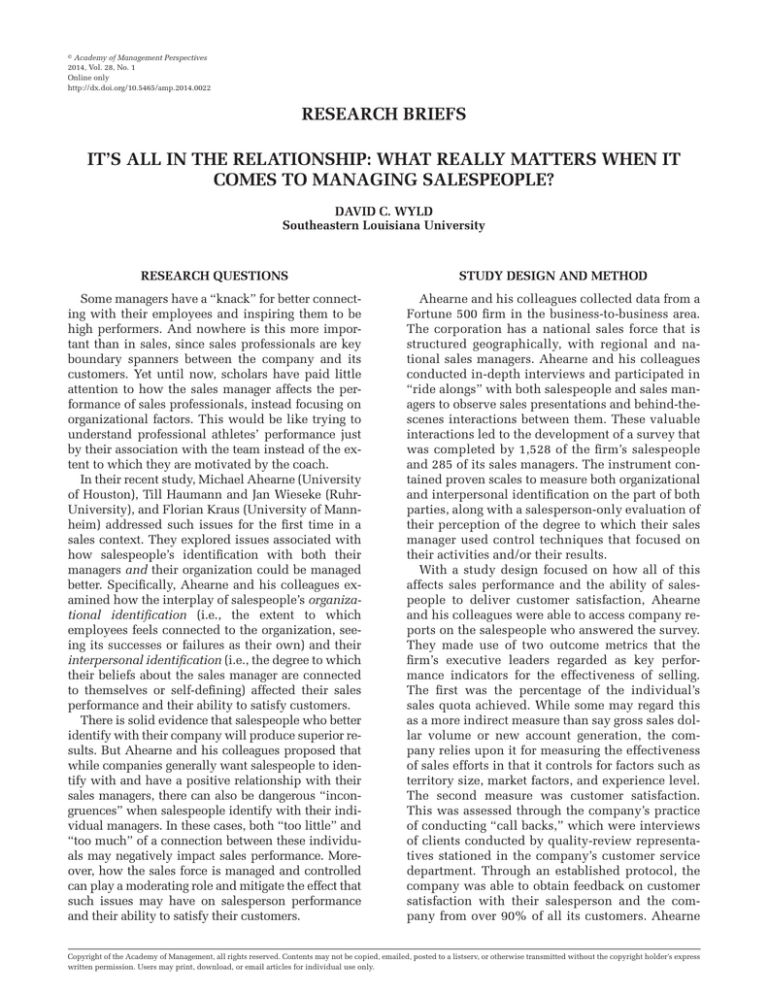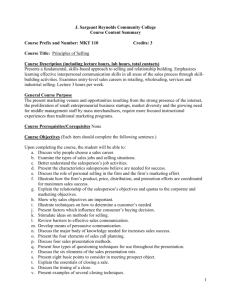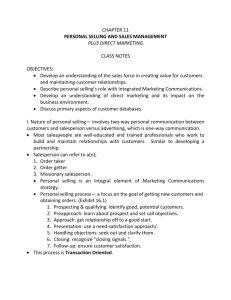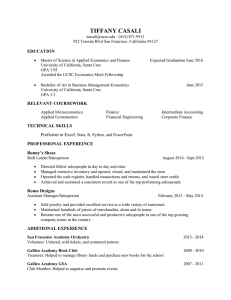RESEARCH BRIEFS COMES TO MANAGING SALESPEOPLE?
advertisement

r Academy of Management Perspectives 2014, Vol. 28, No. 1 Online only http://dx.doi.org/10.5465/amp.2014.0022 RESEARCH BRIEFS IT’S ALL IN THE RELATIONSHIP: WHAT REALLY MATTERS WHEN IT COMES TO MANAGING SALESPEOPLE? DAVID C. WYLD Southeastern Louisiana University RESEARCH QUESTIONS STUDY DESIGN AND METHOD Some managers have a “knack” for better connecting with their employees and inspiring them to be high performers. And nowhere is this more important than in sales, since sales professionals are key boundary spanners between the company and its customers. Yet until now, scholars have paid little attention to how the sales manager affects the performance of sales professionals, instead focusing on organizational factors. This would be like trying to understand professional athletes’ performance just by their association with the team instead of the extent to which they are motivated by the coach. In their recent study, Michael Ahearne (University of Houston), Till Haumann and Jan Wieseke (RuhrUniversity), and Florian Kraus (University of Mannheim) addressed such issues for the first time in a sales context. They explored issues associated with how salespeople’s identification with both their managers and their organization could be managed better. Specifically, Ahearne and his colleagues examined how the interplay of salespeople’s organizational identification (i.e., the extent to which employees feels connected to the organization, seeing its successes or failures as their own) and their interpersonal identification (i.e., the degree to which their beliefs about the sales manager are connected to themselves or self-defining) affected their sales performance and their ability to satisfy customers. There is solid evidence that salespeople who better identify with their company will produce superior results. But Ahearne and his colleagues proposed that while companies generally want salespeople to identify with and have a positive relationship with their sales managers, there can also be dangerous “incongruences” when salespeople identify with their individual managers. In these cases, both “too little” and “too much” of a connection between these individuals may negatively impact sales performance. Moreover, how the sales force is managed and controlled can play a moderating role and mitigate the effect that such issues may have on salesperson performance and their ability to satisfy their customers. Ahearne and his colleagues collected data from a Fortune 500 firm in the business-to-business area. The corporation has a national sales force that is structured geographically, with regional and national sales managers. Ahearne and his colleagues conducted in-depth interviews and participated in “ride alongs” with both salespeople and sales managers to observe sales presentations and behind-thescenes interactions between them. These valuable interactions led to the development of a survey that was completed by 1,528 of the firm’s salespeople and 285 of its sales managers. The instrument contained proven scales to measure both organizational and interpersonal identification on the part of both parties, along with a salesperson-only evaluation of their perception of the degree to which their sales manager used control techniques that focused on their activities and/or their results. With a study design focused on how all of this affects sales performance and the ability of salespeople to deliver customer satisfaction, Ahearne and his colleagues were able to access company reports on the salespeople who answered the survey. They made use of two outcome metrics that the firm’s executive leaders regarded as key performance indicators for the effectiveness of selling. The first was the percentage of the individual’s sales quota achieved. While some may regard this as a more indirect measure than say gross sales dollar volume or new account generation, the company relies upon it for measuring the effectiveness of sales efforts in that it controls for factors such as territory size, market factors, and experience level. The second measure was customer satisfaction. This was assessed through the company’s practice of conducting “call backs,” which were interviews of clients conducted by quality-review representatives stationed in the company’s customer service department. Through an established protocol, the company was able to obtain feedback on customer satisfaction with their salesperson and the company from over 90% of all its customers. Ahearne Copyright of the Academy of Management, all rights reserved. Contents may not be copied, emailed, posted to a listserv, or otherwise transmitted without the copyright holder’s express written permission. Users may print, download, or email articles for individual use only. Academy of Management Perspectives and his colleagues matched these two key outcome measures with the data obtained from the salesperson and his or her sales manager for the month in which the surveys were completed. KEY FINDINGS The results of the survey of salespeople and their respective sales managers, when combined with the sales performance and customer satisfaction outcome metrics, generally confirmed the hypotheses developed by Ahearne and his colleagues. Across a variety of conditions, they found that a congruence in attitudes in the sales manager–salesperson “dyad” will produce more positive desired outcomes: increased sales and more satisfied customers. However, there is a point of diminishing returns in terms of the agreement in mutual admiration, pointing to the fact that if one party in the sales relationship “over-identifies” with the other, there can be cause for concern in terms of managing both the salesperson and the sales manager. For instance, one could see such a relationship setting the stage for not just questionable behaviors to occur (i.e., taking the relationship too personal), but making accurate performance appraisal difficult if not impossible. Likewise, in instances where there was either a notable incongruence in the attitudes of the parties in the sales manager–salesperson dyad or over-identification between them, Ahearne and his colleagues found that this produced negative results in both actual sales production and customer satisfaction. This highlights that sales managers should be aware of their own attitudes toward the salespeople they oversee, and perhaps even more importantly, should be honest in their perception of how they are regarded—not necessarily liked, but respected as a person and able to be identified with—by the sales professionals they supervise. Had the scope of the study been simply to address the issues associated with identification on the personal level, this research would still have made a significant contribution to the literature. However, Ahearne and his colleagues also produced some very practical results with their hypotheses, examining the degree to which various sales force control methods were effective in producing positive sales performance and heightened customer satisfaction. It is interesting to note that they did not take the organization’s “official” methods of evaluation/feedback/monitoring salespeople into account, nor did they survey sales managers on what types of control methods they might personally employ with their sales employees. Rather, the critical measure in this instance was how the salespeople themselves believed that their February sales managers employed either—or both—behaviorbased controls (monitoring the salesperson’s activities) and outcome-based controls (monitoring the salesperson’s ability to produce outcomes). In other words, a higher score on the former category would mean that salespeople felt that their manager focused on activity measures, such as the number of calls made, the number of leads generated, the time spent with customers, etc., whereas a higher rating on the latter would indicate a belief that one’s manager emphasized sales performance measures, such as growth in dollar volumes, new customers, sales in targeted categories, etc. In their discussion of their results, Ahearne and his colleagues provided detailed, prescriptive advice for how sales managers should adjust their use of both types of control mechanisms based on the level of identification between themselves and their salespeople. This highlighted the importance of applying the contingency approach to sales management. And after all, some 50 years ago, Fielder (1964) noted that the leader–member relationship was the first and most important factor to be considered in determining the “favorableness” of a situation for any leader—sales managers included. CONCLUSIONS AND IMPLICATIONS Ahearne and his colleagues have made a significant contribution not just to the marketing literature, but to the practice of marketing. If companies want to ensure that they have the most motivated possible sales staff in place— whether that “place” is the sales floor in a retail establishment or a potential customer’s office— this research provides marketing executives with a new perspective on the critical importance of the relationship between the sales manager and his or her salespeople. Ahearne and his colleagues showed that the perceived identification between a salesperson and his or her manager clearly affects the ability of companies to generate sales productivity and satisfied customers— over and above, and sometimes contrary to—the felt identification between a salesperson and the overall organization. Much like an athlete can be motivated by the fact that he or she admires and identifies with his or her coach, so too will salespeople. On the other hand, as has been seen in sports when locker rooms grow “toxic” and relations sour between a player—or even the whole team—and their coach, performance can wane tremendously. Consequently, the study highlights the need for sales managers to be aware of their own and their salespeople’s regard for one another. Sales managers also must be flexible 2014 and vary their use of behavioral and outcome-based controls to most effectively influence the situation to produce positive outcomes for the company and the individual salesperson. Finally, the work of Ahearne and his colleagues shows how important it is for companies to proactively set the stage for sales managers and salespeople to be better connected. Firms can invest in formal mentoring programs as well as social activities and training events that enable those in sales supervision and in the field to get to know one another better and foster stronger (to a point) relationships. In doing so, firms will have salespeople who are more likely to run through metaphoric walls for their company, Wyld their sales manager, and most importantly, the customer. REFERENCES Ahearne, M., Haumann, T., Kraus, F., & Wieseke, J. (2013). It’s a matter of congruence: How interpersonal identification between sales managers and salespersons shapes sales success. Journal of the Academy of Marketing Science, 41(6), 625–648. doi:10.1007/s11747013-0333-x. Fielder, F. E. (1964). A theory of leadership effectiveness. In L. Berkowitz (Ed.), Advances in experimental social psychology (Vol. 1, pp. 149–190). New York: Academic Press.








